Lighthouses
27 Cape Cod Lighthouses You Won't Want To Miss!
Tourists flock to Cape Cod and the Islands, including Nantucket, Martha’s Vineyard, and Elizabeth. They visit the charming towns, relax on beaches, and explore some of America’s finest and historic lighthouses.
There are 14 historic Cape Cod lighthouses. Some are active, while others are available for tours. Overall there are 27 lighthouses on Cape Cod and the Islands of Martha’s Vineyard and Nantucket that you won’t want to miss visiting!
Cape Cod Lighthouses
Cape Cod has the highest concentration of lighthouses anywhere in the world. The Cape Cod lighthouses were built to help ships navigate the rugged coastline, treacherous water, and dangerous shoals lurking unseen beneath the waves.
The historic lighthouses on Cape Cod and the Islands were built between 1797 and 1961 and survived insurmountable challenges—crumbling structures, fires, and erosion—to be an iconic symbol of America’s burgeoning country.
Many of the lighthouses are listed on the National Register of Historic Places. Today, a few of these lighthouses continue to guide ships through the dangers cloaking the peninsula. Others Cape Cod lighthouses are reminders of the gems dotting our Northeastern shores and operate as inns, vacation rentals, or museums.
Cape Cod lighthouses are unique historical sites that are both relics of the Cape’s rich maritime history and markers of its contemporary maritime and resort cultures. The images of Cape Cod lighthouses are iconic!
Cape Cod Lighthouses
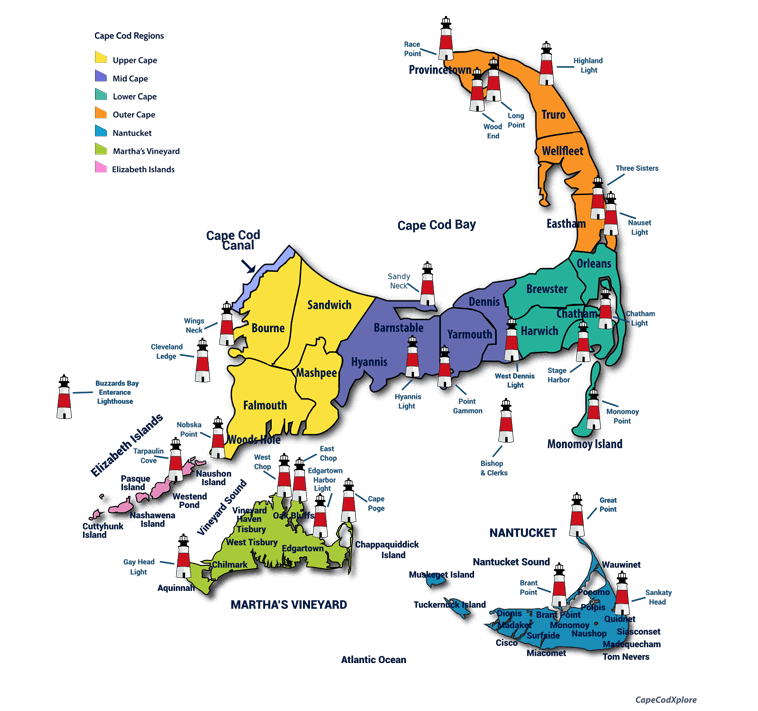
1. Buzzards Bay Entrance Lighthouse (1961)
 Buzzards Bay Entrance Lighthouse (1961) was the first manned lighthouse built in the U.S. over open water. It was initially built in Texas on an offshore oil platform model.
Buzzards Bay Entrance Lighthouse (1961) was the first manned lighthouse built in the U.S. over open water. It was initially built in Texas on an offshore oil platform model.
The living space of this Cape Cod lighthouse was large enough to accommodate five men, and there was even a flat roof to accommodate helicopter operations.
The lighthouse was completed in 1961. It replaced the last series of lightships guiding the vessels into the entrance of Buzzards Bay since the 19th century. In 1980, the lighthouse was automated but replaced in 1996 by a smaller structure with an automated, solar-powered light. It is located at the entrance to Buzzards Bay, about four nautical miles southwest of Cuttyhunk Island, MA.
2. Cleveland East Ledge Light (1943)
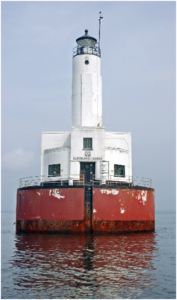 Cleveland East Ledge Light (1943) was supposedly named after President Grover Cleveland, who owned a nearby summer home and enjoyed fishing in the area. It was built between 1940 and 1943, and at the time of building, included a top-of-the-line light, fog signal, and radio beacon.
Cleveland East Ledge Light (1943) was supposedly named after President Grover Cleveland, who owned a nearby summer home and enjoyed fishing in the area. It was built between 1940 and 1943, and at the time of building, included a top-of-the-line light, fog signal, and radio beacon.
The Cape Cod Lighthouse was designed to be sleek and angular and is classified as Art Moderne. Cleveland East Ledge is located roughly two miles from shore atop Cleveland Ledge, on the eastern side of the southern entrance to Cape Cod Canal’s channel. In 1987, it was added to the National Register of Historic Places as Cleveland Ledge Light Station.
3. Bishop and Clerks Lighthouse (1858)

Bishop and Clerks Lighthouse (1858) is located on the offshore ledges with the same names. It was a replacement for a lightship and the Point Gammons Lighthouse. John Peak, the lighthouse keeper at Point Gammons, transferred to be the first lighthouse keeper at Bishop and Clerks. Two other family members followed him to carry on the tradition as keepers of Cape Cod Lighthouses.
It was discontinued as one of the active Cape Cod lighthouses in 1923. Bishop and Clerks fell into disarray, and due to its poor condition, the Coast Guard destroyed the tower on September 11, 1952. A day beacon and buoy now mark the location of the original lighthouse.
4. Point Gammon Lighthouse(1816)
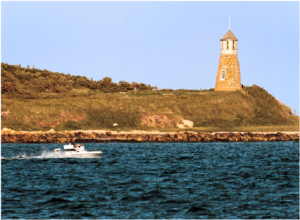 Point Gammon Lighthouse(1816) Is the fourth built of all Cape Cod lighthouses. The stone structure sits atop the southern tip of West Yarmouth’s Great Island, just east of the entrance to Hyannis Harbor.
Point Gammon Lighthouse(1816) Is the fourth built of all Cape Cod lighthouses. The stone structure sits atop the southern tip of West Yarmouth’s Great Island, just east of the entrance to Hyannis Harbor.
“Gammon” comes from an old term that means “to deceive or fool,” and Point Gammon is aptly named for the treacherous waters that deceived sailors and resulted in lost ships and lives.
The lighthouse was cared for by Samuel Adams Peak and then his son, John Peak. In 1855, John Peak recorded 4,969 schooners, 1,455 sloops, 216 brigs, and four steamboats passing the lighthouse. The amount of traffic led to the building of a new lighthouse at Bishop and Clerks, rendering Point Gammon Light unnecessary.
Although Point Gammon Light has long been inactive, its historical significance continues to flank the shore of West Yarmouth. The area surrounding the lighthouse is privately owned, but you can view the lighthouse by boat on one of the tours of Cape Cod lighthouses offered.
5. Brant Point Lighthouse (1746)
 Brant Point Lighthouse (1746) is the second oldest light station. The station was established in 1746 and is located on the southside entrance to Nantucket Harbor. Due to several fires and an unstable foundation, it has been rebuilt and moved several times and is currently housing its tenth light.
Brant Point Lighthouse (1746) is the second oldest light station. The station was established in 1746 and is located on the southside entrance to Nantucket Harbor. Due to several fires and an unstable foundation, it has been rebuilt and moved several times and is currently housing its tenth light.
The last version of the lighthouse was built in 1901, and a brick oil house and range lights were added later. The Lighthouse was automated in 1965, and it is still in operation. It was added to the National Register of Historic Places on October 28, 1987. You can walk around the little conical tower with its black lantern and watch the boats entering and leaving Nantucket Harbor.
6. Sankaty Head Lighthouse (1850)
 Sankaty Head Lighthouse (1850) is located in the village of Siasconset at the easternmost point of Nantucket Island. The name “Sankaty” is believed to be an Indian word meaning “highland” or “cool hill.”
Sankaty Head Lighthouse (1850) is located in the village of Siasconset at the easternmost point of Nantucket Island. The name “Sankaty” is believed to be an Indian word meaning “highland” or “cool hill.”
Local tradition proclaims that early European settlers used the bluffs nearly 100 feet high to look for whales. It was one of the first lighthouses in the United States to receive a Fresnel lens, making it possible to see the light further distances.
In 1965, it was automated and is still in operation. The lighthouse was listed on the National Register of Historic Places as the Sankaty Head Light in 1987. Sankaty was acquired by the ‘Sconset Trust who moved it approximately 400 feet away from the eroding bluff in 2007.
You can visit the lighthouse and walk around the grounds to take in the views or climb the lighthouse (only open semi-annually).
7. Great Point Lighthouse, or Nantucket Light (1784)
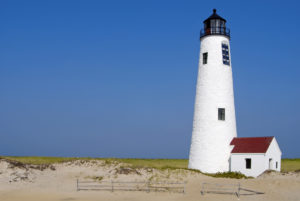 Great Point Lighthouse, or Nantucket Light (1784), is located on the northernmost point of Nantucket Island, where the Atlantic Ocean and the Nantucket Sound meet. By the late 1700s, this passage was one of the busiest areas on the East Coast, even though treacherous conditions made it difficult for mariners.
Great Point Lighthouse, or Nantucket Light (1784), is located on the northernmost point of Nantucket Island, where the Atlantic Ocean and the Nantucket Sound meet. By the late 1700s, this passage was one of the busiest areas on the East Coast, even though treacherous conditions made it difficult for mariners.
The original wooden tower was destroyed by fire. After several rebuilds of wood or stone, the stone tower replica built in 1987 still stands today. Modern amenities to Great Point include solar panels to recharge the light’s batteries. A sheet pile foundation and a thick concrete mat were added to prevent erosion and safely secure the lighthouse.
Because of its location, driving to Great Point can be difficult and could require a vehicle with 4WD. The Trustees of Reservations offers guided natural history tours depending on the time of year and can provide access to the lighthouse.
8. East Chop Lighthouse (1878)
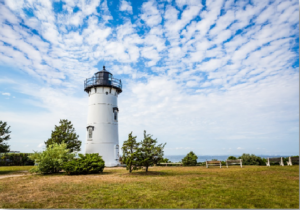 East Chop Lighthouse (1878) is a beautiful historic lighthouse located on a bluff overlooking Vineyard Haven Harbor and Vineyard Sound. A semaphore station was established at East Chop in 1828 to display shipping information.
East Chop Lighthouse (1878) is a beautiful historic lighthouse located on a bluff overlooking Vineyard Haven Harbor and Vineyard Sound. A semaphore station was established at East Chop in 1828 to display shipping information.
However, local citizens like marine merchant Captain Silas Daggett felt that a lighthouse was also necessary. Tired of waiting for authorities to act, Daggett constructed a privately owned lighthouse in 1869. The United States Congress eventually bought the property, destroyed the lighthouse, and built a cast-iron conical tower with an adjacent two-story lightkeeper’s house.
It was first painted a brown-red color, and many East Chop locals fondly called it the “Chocolate Lighthouse.” In 1987, it was added to the National Register of Historic Places. Today, East Chop Lighthouse is managed by Martha’s Vineyard Museum and is open seasonally on Sundays around sunset. It is also available for group visits or private party rentals.
9. Highland Light (1797)
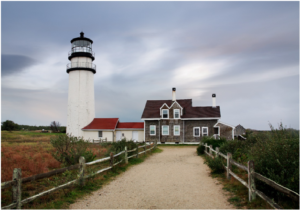 Highland Light (1797), also known as Cape Cod Light, is located in North Truro and is still active. It was the first lighthouse on Cape Cod and the tallest, standing majestically at 66-feet-tall.
Highland Light (1797), also known as Cape Cod Light, is located in North Truro and is still active. It was the first lighthouse on Cape Cod and the tallest, standing majestically at 66-feet-tall.
Before the lighthouse was completed, ships traveling from Europe to Boston had to feel their way along the dark peninsula and into Massachusetts Bay. Many sunk in the shoals just off the coast without a light to guide their way.
For many years after its construction, Highland Light was the first glimpse of America seen by immigrants coming to America from Europe. The current tower was erected in 1857, replacing two earlier towers, including the original.
It is listed on the National Register of Historic Places. Visitors to Highland can visit the grounds and participate in lighthouse climbs during the day or evening and visit the adjacent museum. Highland Light is also available for tours or private party rentals.
10. Chatham Light (1808)
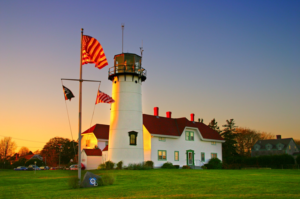 Chatham Light (1808), or Twin Lights, is the second oldest of the Cape Cod lighthouses. It is located at the southeast corner of the Cape and is named after an English seaport.
Chatham Light (1808), or Twin Lights, is the second oldest of the Cape Cod lighthouses. It is located at the southeast corner of the Cape and is named after an English seaport.
Chatham was originally built with two towers to differentiate it from Highland Light and improve its beacon range. Eventually, one of the towers was moved to the Eastham area and became Nauset Light.
Chatham Light has played an integral role in keeping Chatham Harbor safe through the years. In 1952, for example, Coast Guard personnel stationed at the lighthouse conducted a daring and successful rescue of the crew members of the SS Pendleton.
The light was automated in 1982 and actively guides mariners to safety. The lighthouse keeper’s dwelling is used for Coast Guard housing. Due to maintenance, only summer tours of the lighthouse exterior and grounds are permitted until further notice.
11. Race Point Light (1816)
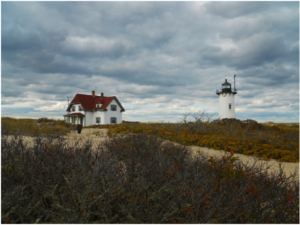 Race Point Light (1816) is perched on the very tip of the Cape Cod peninsula in Provincetown. The water around the peninsula was particularly treacherous for sailors.
Race Point Light (1816) is perched on the very tip of the Cape Cod peninsula in Provincetown. The water around the peninsula was particularly treacherous for sailors.
The lighthouse name comes from the word race, which means “of a strong cross current.” The tower was replaced in 1876 with a larger iron-plated 45-foot tower lined with bricks.
Visitors today will not see the original keeper’s house but can visit the second smaller dwelling, built for an assistant lighthouse keeper. Race Point Light was added to the National Register of Historic Places in 1987.
It is maintained by the Coast Guard, but the Cape Cod Chapter of the American Lighthouse Foundation operates the property. They also rent out the two buildings—the Keeper’s House and the Whistle House—for overnight stays.
To reach the lighthouse by foot is approximately a 45-minute sandy walk. You can drive to the lighthouse in a four-wheel-drive vehicle if you have a National Park Service Overland Permit.
12. Monomoy Point Light (1823)
 Monomoy Point Light (1823) sits on Monomoy Island, a sandspit that extends from Chatham south into Nantucket Sound. The moving shoals around this sandspit once spelled doom for ships skirting the edge of the Cape as they moved between New York and Boston.
Monomoy Point Light (1823) sits on Monomoy Island, a sandspit that extends from Chatham south into Nantucket Sound. The moving shoals around this sandspit once spelled doom for ships skirting the edge of the Cape as they moved between New York and Boston.
To prevent shipwrecks, Chatham erected the first lighthouse on the sandspit in 1823. However, the current cast-iron structure dates back to 1849. When Cape Cod Canal was completed in 1914, traffic around outer Cape Cod lessened, and Monomoy Point Light was deactivated.
It was added to the National Register of Historic Places as Monomoy Point Lighthouse in 1979. The lighthouse was built in an area that is difficult to get to. However, some ferries will take you to Monomoy and back in the summer. From the ferry, you can hike to visit the lighthouse.
13. Sandy Neck Light (1826)
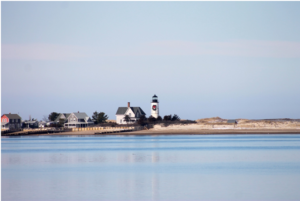 Sandy Neck Light (1826) marks the entrance to Barnstable Harbor. The lighthouse sits at the end of Beach Point near Sandy Neck Beach in Barnstable.
Sandy Neck Light (1826) marks the entrance to Barnstable Harbor. The lighthouse sits at the end of Beach Point near Sandy Neck Beach in Barnstable.
Since 1826, this rugged lighthouse was deemed necessary to guide ships around the dangerous sand bar that extends from Sandy Neck. In 1857, the original lighthouse was replaced by the 48-foot brick tower that still stands today.
Since Sandy Neck’s deactivation in 1931, the tower was replaced with a skeleton tower. Sandy Neck Light was re-lit in 2007 as a private aid to navigation. The lighthouse is privately owned and is not open to the public. You can see the lighthouse, keeper’s house, and oil house from boats leaving Barnstable Harbor to whale watch.
14. Long Point Light (1827)
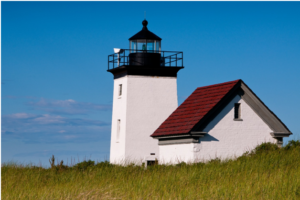 Long Point Light (1827) is located at the mouth of Provincetown Harbor. Its name is derived from the sandy spit it rests upon.
Long Point Light (1827) is located at the mouth of Provincetown Harbor. Its name is derived from the sandy spit it rests upon.
Long Point Light Station was established to guide mariners into the bustling fishing port of Provincetown Harbor. A lighthouse inspector believed the light station could be easily carried out to sea by a strong storm, so a 38-foot tall, square, brick lighthouse and a keeper’s dwelling were built in 1875.
Long Point Light underwent automation in 1952 that included a modern optic lens. Around 1982, solar panels were installed to power the light and fog signal equipment. The keeper’s dwelling and fog signal buildings were demolished. Today, Long Point Light still guides mariners in and out of Provincetown Harbor.
Long Point Light is owned by the U.S. Coast Guard and maintained by the Cape Cod Chapter of the American Lighthouse Foundation. The light tower is closed, but the grounds are open to the public. From MacMillan Wharf, Long Island Light is visible, but it is best visible by boats leaving Provincetown Harbor. Long Point Light is accessible by boat or a 3-mile hike over a jetty.
15. Nobska Point Lighthouse (1829)
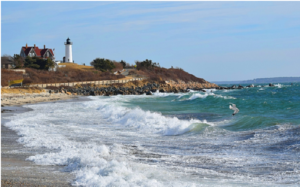 Nobska Point Lighthouse (1829), originally called Nobsque Light, is located near Woods Hole village and the division between Buzzards Bay, Nantucket Sound, and Vineyard Sound. Woods Hole village is located between New Bedford and Nantucket.
Nobska Point Lighthouse (1829), originally called Nobsque Light, is located near Woods Hole village and the division between Buzzards Bay, Nantucket Sound, and Vineyard Sound. Woods Hole village is located between New Bedford and Nantucket.
It was a hub for the booming local whaling industry in the early nineteenth century. The light station includes the tower and three buildings: the keeper’s, the radio beacon, and the oil house.
In 1985 the lighthouse was automated, and the last keeper, Charles Tebo, retired. The keeper’s house was then converted into the residence for the Commanding Officer of United States Coast Guard Sector Southeastern New England, who moved out in 2012 due to maintenance issues.
The Friends of Nobska Light support and maintain the property. The grounds can be explored year-round from dawn to dusk, but the tower tours are dependent on weather and volunteers. It is listed on the National Register of Historic Places.
16. Three Sisters Lighthouses (1892)
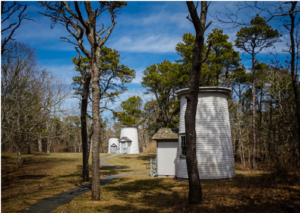 Three Sisters Lighthouses (1892), or the Eastham Lighthouses, is a collection of three beacon towers located on Nauset Beach in Eastham, MA.
Three Sisters Lighthouses (1892), or the Eastham Lighthouses, is a collection of three beacon towers located on Nauset Beach in Eastham, MA.
Mariners thought they looked like black-hatted women dressed in white from the sea looking shoreward, hence earning their nickname, “Three Sisters.”
This is the only place in the country where three light towers were built in one location. In 1836, the town chose to construct a lighthouse with three towers to distinguish it from the two towers of Chatham Lighthouse and the single tower of Highland Lighthouse.
Due to coastal erosion and poor maintenance, the towers fell into the sea in 1890. A couple of years later, they were moved and replaced with larger, wooden towers on bricks. They were decommissioned in 1911, except for the center tower.
It was nicknamed the “Beacon” and flashed three times in homage to the trio when lit. The Beacon was attached to the keeper’s house and operated until its replacement by the Nauset Light in 1923.
Today, the restored towers are open to the public for tours from mid-May through October. The Nauset Light Preservation Society operates, maintains, and interprets the site, having signed a partnership agreement with the National Park Service since 2004.
17. Hyannis Rear Range Light (1849)
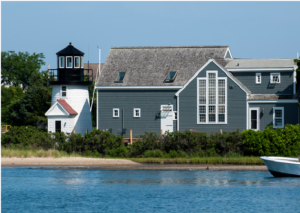 Hyannis Rear Range Light (1849), or the Hyannis Harbor Light, was a lighthouse in Hyannis village on Cape Cod. A front range light was added, and the pair of range lights guided ships to the Old Colony Railroad Wharf.
Hyannis Rear Range Light (1849), or the Hyannis Harbor Light, was a lighthouse in Hyannis village on Cape Cod. A front range light was added, and the pair of range lights guided ships to the Old Colony Railroad Wharf.
The lights helped ships unload goods like coal and lumber, grain, and fish onto trains. Because the lighthouse was only meant to guide nearby ships to and from the railroad wharf, it stands shorter than the Cape’s other lighthouses. From top to bottom, it measures just 20 feet in height.
The water traffic shifted to Lewis Bay and Hyannis inner harbor when the adjacent Lewis Bay was dredged, leaving the wharf unused. In 1929, the lights were discontinued, and the front range light disappeared along with the wharf. From Harbor Road in Hyannis, you can see Hyannis Rear Range Light views. Since the lighthouse is a private residence, it is closed to the public.
18. Wings Neck Lighthouse (1849)
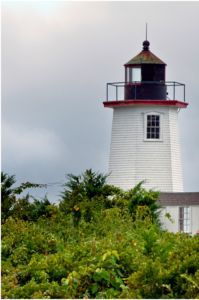 Wings Neck Lighthouse (1849) is located at the tip of Wings Neck Point in the village of Pocasset. Its location has some of the most beautiful panoramic views of the Atlantic Ocean.
Wings Neck Lighthouse (1849) is located at the tip of Wings Neck Point in the village of Pocasset. Its location has some of the most beautiful panoramic views of the Atlantic Ocean.
In the mid-nineteenth century, the ports of Wareham and Sandwich saw a significant increase in marine traffic, and in response, the federal government commissioned the lighthouse.
The lighthouse and keeper’s home had to be rebuilt due to a fire in 1889. For many years, Wings Neck was one of the most important lighthouses on the Atlantic Coast due to the heavy shipping in the Cape Cod Canal.
New technology, however, was making Wings Neck obsolete, and it was deactivated in 1945. It was completely renovated in 2003 and serves as a vacation rental owned and managed by the Wing’s Neck Lighthouse Trust. Guests can book a stay in the keeper’s home and tour the lighthouse throughout the year.
19. West Dennis Light (1855)
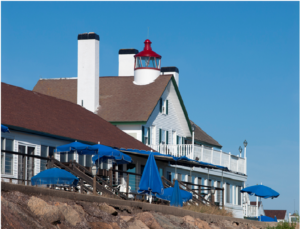 West Dennis Light (1855) is located in the small village of West Dennis, at the mouth of the Bass River on the Nantucket Sound. It was previously known as the Bass River Light.
West Dennis Light (1855) is located in the small village of West Dennis, at the mouth of the Bass River on the Nantucket Sound. It was previously known as the Bass River Light.
Like many early Cape Cod lighthouses, West Dennis Light combined the tower and keeper’s house into one building by placing a raised beacon on the house’s roof. This structural design was prone to leaking, so lighthouses were later built with self-standing towers.
It is the only lighthouse on Cape Cod that is built with this design. It was decommissioned in 1914 and later purchased by State Senator Everett Stone with the intention to develop the land. The paperwork was passed too late, so they took in guests to help pay the mortgage.
Guests wanted to return, so Stone changed his mind about developing the land and instead started a three-generation family business managing the Lighthouse Inn. The light lay dormant for 75 years but was re-lit as one of the few privately owned, privately maintained working lighthouses in the country.
20. Wood End Lighthouse (1872)
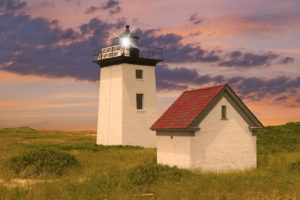 Wood End Lighthouse (1872) is perched on the desolate Wood End Bar, located west of the entrance to Provincetown Harbor. Wood End Light is identical to nearby Long Point Light, which was restored three years after Wood End Light was completed using the same design.
Wood End Lighthouse (1872) is perched on the desolate Wood End Bar, located west of the entrance to Provincetown Harbor. Wood End Light is identical to nearby Long Point Light, which was restored three years after Wood End Light was completed using the same design.
The two lighthouses also have identical fog horns, which call back and forth in bad weather. When it was active, Wood End Lighthouse included a tower, keeper’s house, storage shed, and oil house. They razed the buildings and left the tower and oil house when it became inactive in 1896.
Wood End Light became the first Massachusetts lighthouse to use solar energy to power the light and fog signal equipment. Wood End Lighthouse was added to the National Register of Historic Places in 1987. The Cape Cod Chapter of the American Lighthouse Foundation is the guardian to Wood End and Long Point Light
The lighthouse is not currently open to the public. Still, many people enjoy hiking the challenging route to Wood End Lighthouse. Others combine the hike with a visit to Long Point Light.
21. Stage Harbor Light (1880)
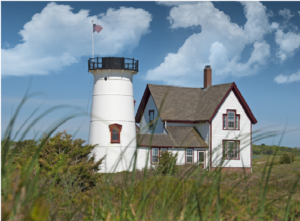 Stage Harbor Light (1880), also known as Harding’s Beach Lighthouse, in Chatham marks the entrance to Stage Harbor. It’s the youngest lighthouse on Cape Cod.
Stage Harbor Light (1880), also known as Harding’s Beach Lighthouse, in Chatham marks the entrance to Stage Harbor. It’s the youngest lighthouse on Cape Cod.
One day, Alfred A. Howard, the first keeper, discovered a card in a bottle. It stated that the finder was entitled to five dollars. The card was placed in the bottle by Thomas W. Cahill, a delegate of the American Amateur Football Association. Cahill was returning from the Stockholm Olympic games when he threw the bottle overboard. Little did he know that the bottle would travel roughly 1,200 miles in fifty-five days.
In 1933, the lighthouse was discontinued and replaced by a skeleton tower 200 feet west of the original site. The skeleton tower is active and continues to guide ships along the foggy coast with periodic flashes of white light.
When the government sold the lighthouse, army officer Henry Sears Hoyt purchased it, and it remains in the family. Occasionally, the family will open the lighthouse to the public for viewing.
22. Nauset Beach Light (1923)
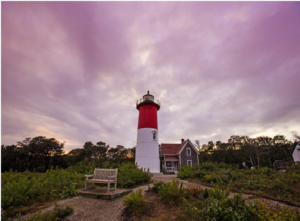 Nauset Beach Light (1923) is the most famous and photographed lighthouse on Cape Cod. For chip lovers, it is best known as the iconic lighthouse logo from Cape Cod Potato Chips.
Nauset Beach Light (1923) is the most famous and photographed lighthouse on Cape Cod. For chip lovers, it is best known as the iconic lighthouse logo from Cape Cod Potato Chips.
Nauset is perched on the northern end of Coast Guard Beach. Nauset Beach Light is a restored lighthouse erected in 1923 using one of the towers of Chatham Light.
Originally the tower was white, but painters restored the tower in the 1940s with red as a day marker and giving it its icon red and white appearance. It is made of cast iron with a brick lining that majestically rises 48 feet tall. Nauset Beach Light is on the National Register of Historic Places.
The National Park Service owns the lighthouse and keeper home. Still, a private citizen has permission to reside in the keeper’s house until 2024. The Nauset Light Preservation Society operates and manages the upkeep of the lighthouse. Tours to Nauset Beach Light are free to the public.
23. Cape Poge Light (1801)
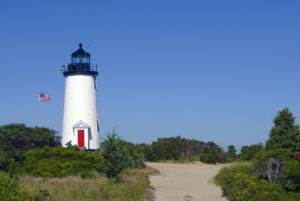 Cape Poge Light (1801), sometimes spelled “Pogue,” is located at the northeast tip of Chappaquiddick Island and slightly east of Martha’s Vineyard. It guided ships through Muskeget Channel and into Edgartown Harbor.
Cape Poge Light (1801), sometimes spelled “Pogue,” is located at the northeast tip of Chappaquiddick Island and slightly east of Martha’s Vineyard. It guided ships through Muskeget Channel and into Edgartown Harbor.
Due to storms and land erosion, the tower was rebuilt twice. The second rebuild in 1893 still stands even though officially, it was a temporary tower that withstood four moves to evade falling into the sea.
Cape Poge Lighthouse was automated in 1943, and the tower remains an active aid to navigation. The keeper’s house was sold to a resident in 1954 and torn down for the lumber.
The automated lantern in Cape Poge Light is maintained by the U.S. Coast Guard. The Trustees of Reservations own the land and manage and operate the lighthouse. It is open year-round to the public, and family-friendly tours are offered.
24. Edgartown Harbor Light (1828)
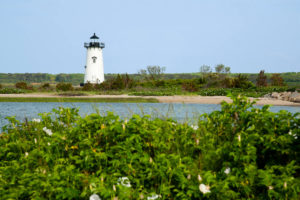 Edgartown Harbor Light (1828) was the first lighthouse built at the entrance to Edgartown Harbor. The lighthouse was a two-story Cape Cod-style wooden structure that also served as the keeper’s house.
Edgartown Harbor Light (1828) was the first lighthouse built at the entrance to Edgartown Harbor. The lighthouse was a two-story Cape Cod-style wooden structure that also served as the keeper’s house.
Edgartown Harbor sat offshore on pilings in shallow water, and for two years, the keeper had to row a short distance to reach the mainland. To remedy the problem, a wooden causeway was built in 1830, which became known locally as the “Bridge of Sighs,” due to the emotions that surfaced from the women watching men about to leave on whaling voyages.
Since it was built on an artificial island in shallow water, the accumulating sand around the stone causeway eventually connected it to the mainland. Edgartown Harbor was rebuilt and repaired until 1839, when it was demolished and replaced by the current cast-iron tower relocated from Ipswich Rear Range Light. In season, the lighthouse is open to the public or for wedding and private party rentals.
25. Gayhead Light (1799)
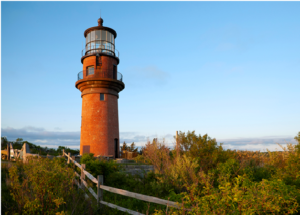 Gayhead Light (1799) is the first lighthouse built on Martha’s Vineyard. It is a historic lighthouse located on the westernmost point of Lighthouse Road in Aquinnah, MA.
Gayhead Light (1799) is the first lighthouse built on Martha’s Vineyard. It is a historic lighthouse located on the westernmost point of Lighthouse Road in Aquinnah, MA.
A contract to build a wooden lighthouse structure with a keeper’s cottage and outbuildings was approved by President John Adams. At the time, Gayhead was considered one of the most important lighthouses, and a new brick tower was built to house one of the first Fresnel lenses.
By the 1950s, they fully automated Gayhead and tore down the keeper’s cottage. However, due to costly maintenance expenses, the lighthouse was closed until fundraising efforts opened it to the public in 1986. Another fundraising effort ensued to save Gayhead from sliding into the ocean, which moved the lighthouse about 134 feet from the original site and secured its stability for years to come. Visitors can visit Gayhead Light from June to October.
26. Westchop Light (1817)
 Westchop Light (1817) is located on the northern tip of West Chop, at the entrance of Vineyard Haven Harbor in Tisbury and a few miles from the village of Vineyard Haven.
Westchop Light (1817) is located on the northern tip of West Chop, at the entrance of Vineyard Haven Harbor in Tisbury and a few miles from the village of Vineyard Haven.
Westchop lighthouse was a twenty-five-foot-tall rubblestone tower that included an accompanying stone dwelling. By the late 1800s, West Chop had become a popular vacation spot, with homes obscuring the tower. The light was moved several times before being placed in a taller red brick tower.
It is the last lighthouse to be automated (1976) on Martha’s Vineyard. The National Park Service has included Westchop Light Station on the National Register of Historic Places since 1987. The property is owned by the U.S. Coast Guard and is off-limits to the public. Good views of the lighthouse can be seen from the road and many ferries to Martha’s Vineyard.
27. Tarpaulin Cove Lighthouse, Gosnold, MA
 Tarpaulin Cove Lighthouse, Gosnold, MA – Tarpaulin Cove Light is the sole lighthouse in the Elizabeth Islands. It is located on the largest island, Naushon Island, and is a registered National Historic Site.
Tarpaulin Cove Lighthouse, Gosnold, MA – Tarpaulin Cove Light is the sole lighthouse in the Elizabeth Islands. It is located on the largest island, Naushon Island, and is a registered National Historic Site.
In the 19th century, the light became an invaluable tool marking passage on Vineyard Sound, the second busiest shipping passage. The light was originally built by a resident, Zaccheus Lumbert, in 1759. He asked the government to provide funding and manage the lighthouse, and in 1891, the government made significant upgrades to repair the lighthouse.
The upgrades included a temporary structure and the current brick tower, which rises 38 feet into the air. The light was automated in 1941 by the Coast Guard and continues to aid navigation. In 2001, the Cuttyhunk Historical Society and the Naushon Trust won a license from the Coast Guard and will serve as caretakers for the site and structure for 25 years. The lighthouse is not open to the public, but the Cuttyhunk Historical Society offers a summer tour each summer.

